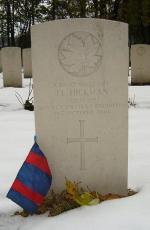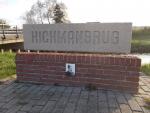John Lockhart Hickman was born in Portage La Prairie, Manitoba, the son of Jesse James and Sarah Elizabeth Hickman. He had been working as a pipefitter and mechanic for the Ontario Hydro Commission for 12 years when he came to live with his parents in Victoria, BC. He enlisted in the Canadian Army in Esquimalt, BC on 27 April 1940 and was immediately sent to the 6th Field Company, Royal Canadian Engineers in North Vancouver where he was classified as Engine Artificer Group ‘B’.
The company re-located to Camp Debert, Nova Scotia in August where they continued individual and unit training before arriving in the United Kingdom the following July after two weeks at sea. While the 6th Field Company was part of 3rd Canadian Infantry Division Engineers, on arrival, platoons were attached to the 2nd Battalion, RCE as part of the Canadian Military Headquarters (CMHQ) Works Programme building camps, roads, hospitals and defence works. They were released back to their division in September.
Over the next three years, the 3rd Division engineers trained in preparation for the invasion. John advanced through the ranks and developed a wide range of field engineering skills and qualifications – combined operations, bridging, mine clearance, chemical warfare, defence works, personal weapons proficiency, and leadership. By April 1944, was considered an expert in improvised bridge construction. He also became a qualified motorcyclist.
The Lance-Sergeant Lockhart landed in Normandy beaches at Courselles-sur-Mer on D-Day. While the 6th Field Company distinguished itself that day with two Military Medals, the cost was high - 11 killed and several wounded. Fighting continued through the summer until the breakout in late August. During that time, the 6th Field Company marked a significant "anniversary". On 7 August 1940, four long years back, the unit had left its home station in North Vancouver for Camp Debert. Of the 240 odd in the Company on departure, there were now only some 40 "originals" on strength, John Hickman among them.
In September, they crossed the Seine and moved on to clearing the Channel Ports. These operations involved bridging, roadblock removal, and lifting minefields. Acting Sergeant Lockhart’s skills with improvised bridging techniques using locally ‘acquired’ materials were put to the test as the advance was outrunning the supply of Bailey bridging equipment. By the first week in October, they were deeply involved in the Battle of the Scheldt supporting the 3rd Division through Operation SWITCHBACK to clear the Breskens Pocket.
From Volume II of the History of the RCE:
“The last stage began on the 30th, when both the 8th and 9th Brigades got troops over the Uitwaterings Canal. Beginning at 0530 hours on the last day of October the 6th Field Company bridged the Canal near Retranchement. Lieutenant J. H. Alexander won the Military Cross for his efforts during the operation; to allow an early start, he had crossed the Canal and carried out the necessary detailed reconnaissance before a bridgehead had been established. The bridge opened at 1500 hours. The engineers lost one man seriously wounded by a Schu. Mine (buried in the floor of a roadside slit trench) and, later in the day, Sergeant J. L. Hickman, the bridge commander was killed, and five were wounded, when the enemy shelled the bridge site.”
In recognition of the high regard in which John Hickman was held, the bridge was named the Hickman Bridge. A memorial now marks its original location.
Sergeant John Lockhart Hickman is buried in the Adegem Canadian War Cemetery in Antwerp, Belgium.
Note: John had married Angelia Hutchings in England just two weeks before the D-Day landings. She was a war widow and with her child settled in Victoria with Johns parents after the war. He also had four brothers who served during the war, two in the army (Italy and Northwest Europe), and two in the navy (HMCS La Malbaie and HMCS St Hyacinth).
Return to Part 5: Tributes to the Fallen Sappers of the Scheldt


